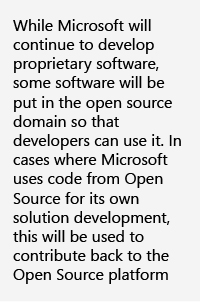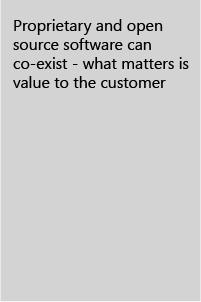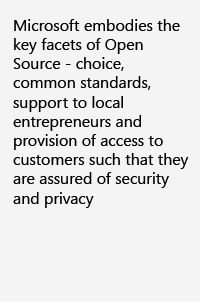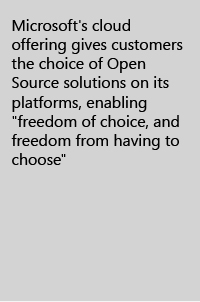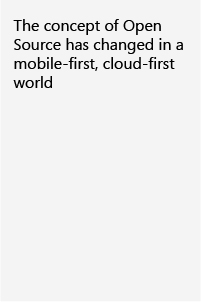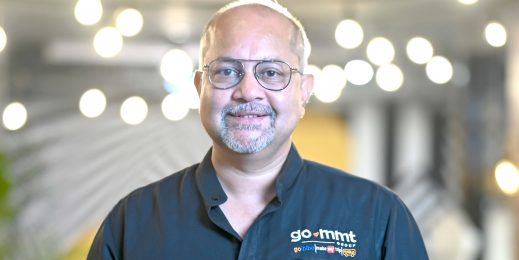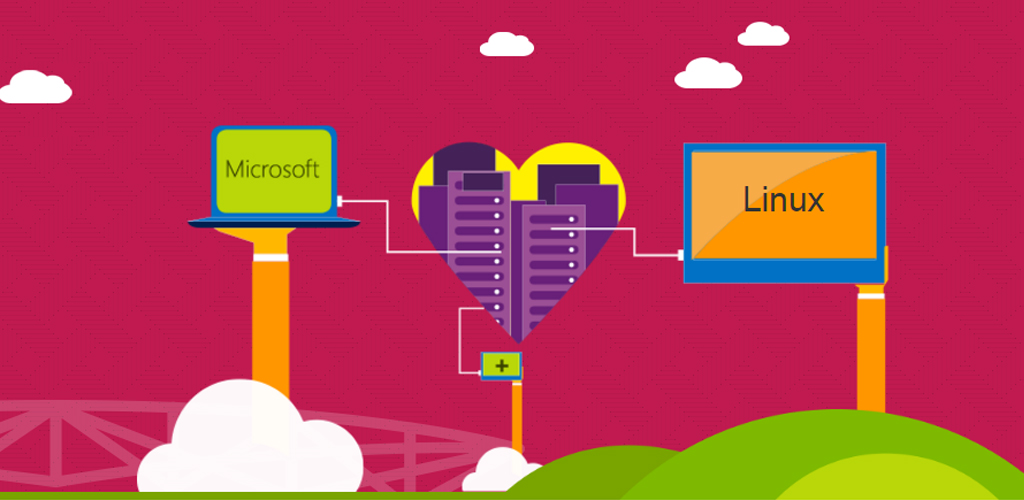
Connecting technologies: Openness for productivity in a mobile-first, cloud-first world
 The founders of vMukti started their company with a vision: provide customers with low-cost and high-quality total video, voice and content solutions.
The founders of vMukti started their company with a vision: provide customers with low-cost and high-quality total video, voice and content solutions.
They developed their open applications on the Windows platform. These include vMukti MeetingPlace for conferencing, vMukti BizCom for call centers, and vMukti SoLite for social networking.
Initially, VMukti considered Linux as an alternative platform. But they found that the Microsoft software framework provided a very easy P2P architecture and was hence a better fit.
VMukti’s peer-to-peer Framework, used on top of the Windows .Net platform, was more flexible in terms of the development environment than anything a simple Open Source could have provided. They were able to do a lot more with its applications by using the .Net Framework to make them more versatile and user-friendly.
Through its association with Microsoft, vMukti was able to harness the advantage of openness, gaining instant access to individuals and organizations that might be open to trying out its applications.
To most people, the idea that Open Source and Microsoft could share a platform was unthinkable.
However, the reasoning was simple enough: This new, more open approach was about interoperability, open standards and Open Source. And it was resonating with the market and showing how Microsoft was making real progress in its journey to becoming the leading productivity and platform company in a mobile-first and cloud-first world.
“There’s a new Microsoft in town. We’re really interested in providing a platform for Open Source software developers to build their businesses.”
Mark Hill, Vice-President (Open Source Marketing and Sales) at Microsoft
Microsoft and Openness
At the recently concluded Microsoft Azure Conference in Pune on March 18 and 19, 2015, Mark Hill, Vice-President (Open Source Marketing and Sales) at Microsoft, said, “We need to understand what they (customers) are using and build products around that need. We are a small team in Redmond. We are going to appoint 50 Openness Leads across the globe to spearhead the initiative and to spread the word. We have already appointed 35 Leads.”
Also present at the conference were Tyler Bryson, General Manager- Marketing, Microsoft India, and Balaji Kesavaraj, who has been appointed the Openness Lead for Microsoft India and will be a part of Hill’s team.
Prior to the conference Bryson had said, “Microsoft Azure has seen more than 300 enhancements in just the last one year. This rapid pace of innovation has fueled excitement and enthusiasm across the entire cloud ecosystem. Discussions at the Microsoft Azure Conference will bring our customers and partners closer to these innovations with real-life scenarios, exchange of ideas with experts, and learning from thought leaders.”
“Microsoft Azure has seen more than 300 enhancements in just the last one year. This rapid pace of innovation has fueled excitement and enthusiasm across the entire cloud ecosystem.”
Tyler Bryson, General Manager – Marketing, Microsoft India
So how has Microsoft’s approach to Open Source changed?
Microsoft’s strategy towards Open Source is based on the belief that interoperability is a lever for business growth, in the cloud and on mobile devices. This puts Microsoft in the unique position of being able to deliver cloud computing across the private, public and hybrid cloud, with Linux/OSS as a first-class citizen across all these environments.
Microsoft’s commitment to openness and collaboration is ingrained in its day-to-day approach to doing business alongside industry partners around the world, including open source communities. The popularity of Microsoft’s new strategy in India was evident at the Pune conference, which was attended by more than 1,500 business leaders, software developers, technology enthusiasts, IT professionals, customers and users of the Microsoft Azure platform.
Nearly 15,000 participants joined the conference online, which made this the largest gathering of cloud computing professionals in India. Content from the conference is likely to reach 100,000 people via webinars, partner-led sessions, social outreach, engagement with user-group communities and more.
Microsoft’s Approach to Open Source
Microsoft has evolved its open source strategy following continuous dialogue with its customers, most of whom operate heterogeneous IT environments with traditional commercial software, commercial open source software and community-based open source software working side-by-side.
“There is not a single Open Source company that doesn’t want to work with us. We are a big provider of cloud. Everybody loves to jump on to Azure. It’s fair to say that AWS and Google have been working longer than us, but what all these companies like about Microsoft is that we are a platform company and we are only successful when they are successful. We are not going to access their customer data, mine it and put it into our next product, and sell stuff to them. Plus, if you look at how much software we contribute back, we would rival everyone,” said Mark Hill, speaking at the Pune conference.
Cloud Accelerator Program
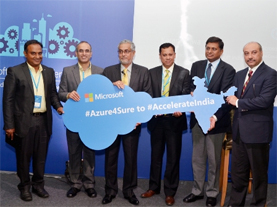 The Pune Conference also saw the launch of a special Cloud Accelerator Program aimed at helping Indian enterprises and government organizations take full advantage of the cloud. The program has been designed with the help of in-house experts and trained partners to help customers in India start and complete their cloud journey. More than 15 partners including HCL, Wipro and Tech Mahindra have signed up for the rollout.
The Pune Conference also saw the launch of a special Cloud Accelerator Program aimed at helping Indian enterprises and government organizations take full advantage of the cloud. The program has been designed with the help of in-house experts and trained partners to help customers in India start and complete their cloud journey. More than 15 partners including HCL, Wipro and Tech Mahindra have signed up for the rollout.
Bimal Das, Joint President, Enterprise Products Distribution, HCL Infosystems Ltd. said, “We would like to congratulate Microsoft for launching the Cloud Accelerator Program and for bringing a comprehensive set of cloud offerings to India. We see huge headroom for growth in the cloud market in India. The Cloud Accelerator Program will provide a platform to form enterprises of all sizes to scale up their efficiency, while reducing IT infrastructure costs.”
Speaking at the conference, Bhaskar Pramanik, Chairman, Microsoft India said: “The Cloud Accelerator Program has been designed to help India move to the cloud, and in turn help “Make in India” a reality. This will open up new possibilities in e-governance, financial inclusion healthcare and education to positively impact the lives of a billion people.”
Customers are also very optimistic about the new Cloud Accelerator Program.
Rostow Ravanan, Executive Director and CFO of MindTree Ltd. said, “We have seen faster adoption of Microsoft Azure over the past year. The all-round focus of Microsoft’s cloud enables us to apply these services to multiple customer situations. I believe the new services have erased the early mover advantage of other cloud providers and we are seeing Azure take the lead in services like IoT and media services. The focus on open source technologies has been an advantage. We now have more than 80% of our workforce on Office 365.”
The way ahead
Microsoft’s previous view on Open Source has seen a total change, now that developers on Azure are able to use “just about any open source tool”.
According to Mark Hill: “There’s a new Microsoft in town. We’re really interested in providing a platform for open source software developers to build their businesses.”
There is also an acknowledgement that it may take a while for Microsoft to convince skeptics in the open source community that Microsoft has their best interests at heart. But with all that’s been achieved in a journey that’s just begun, that too looks almost certain to happen.





